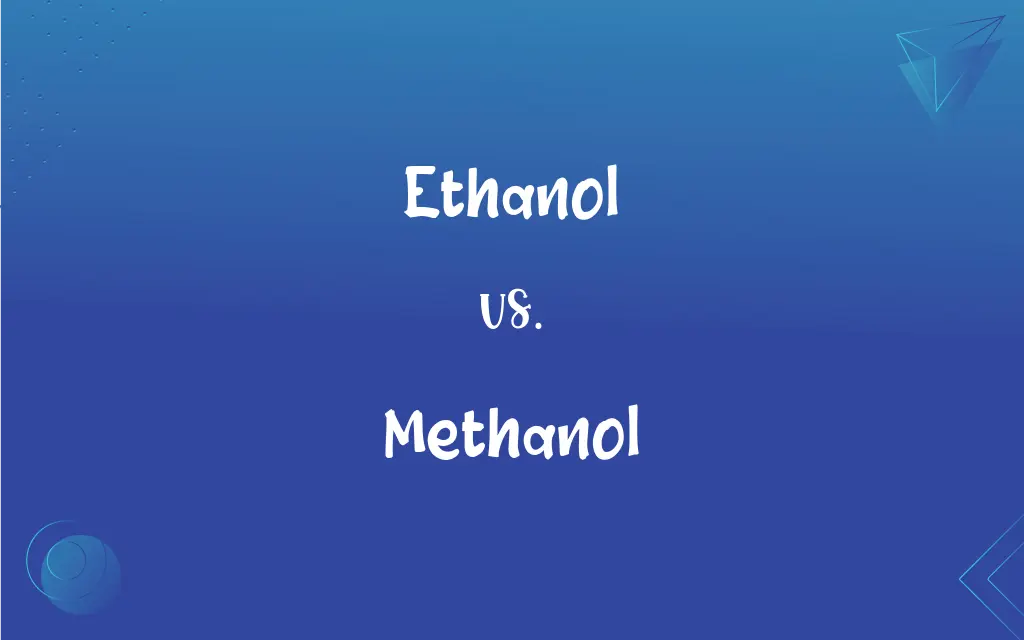Ethanol vs. Methanol: What's the Difference?
Edited by Aimie Carlson || By Harlon Moss || Updated on October 12, 2023
Ethanol is a consumable alcohol found in beverages, while methanol, a toxic alcohol used industrially, is lethal if ingested.

Key Differences
In the world of organic compounds, ethanol and methanol are alcohols, distinguished by their differing molecular structures and uses. Ethanol, with its two-carbon structure, is often found in alcoholic beverages and is consumable in moderation. Conversely, methanol, comprised of a single carbon atom in its molecular structure, is not safe for consumption due to its toxic nature. Both are clear, volatile liquids, yet their applications diverge significantly due to these fundamental disparities.
In industrial and commercial applications, ethanol and methanol serve distinct purposes. Ethanol is widely utilized for human consumption in beverages such as beer, wine, and spirits. It is also employed as a fuel additive (ethyl alcohol) due to its capacity to reduce carbon emissions. Methanol, conversely, is generally applied in industrial processes, being used as a solvent, antifreeze, and fuel. It is not suitable for human consumption and is perilous if ingested, causing conditions like blindness or even death.
From a chemical perspective, ethanol (C2H5OH) and methanol (CH3OH) present unique reactive behaviors. Ethanol is a common reagent in laboratories and is often used as a disinfectant in medical environments, particularly in hand sanitizers, due to its ability to kill many pathogens. Methanol, while also utilized in laboratories, is typically employed in the production of formaldehyde and other chemicals, yet always with cautious handling due to its toxicity and volatility.
Considering bio-fuels and sustainable energy sources, ethanol is often hailed for its potential in this sphere. Derived from plants like sugarcane and corn, ethanol is a renewable fuel that holds promise for reducing society’s carbon footprint. Methanol can be derived from organic matter too but is commonly synthesized from natural gas in an industrial context. Both can be used in fuel cells, offering cleaner energy solutions than conventional fossil fuels.
Navigating through the pathways of environmental impacts, ethanol, and methanol once again showcase their respective characteristics. Ethanol, particularly when derived from organic sources, can offer a somewhat sustainable alternative to fossil fuels. Methanol, while utilized in creating eco-friendly products like biodiesel, demands cautious and limited release into the environment due to its potential to contaminate water and soil, presenting stark contrasts in their respective ecological footprints.
ADVERTISEMENT
Comparison Chart
Chemical Formula
C2H5OH
CH3OH
Consumability
Safe in moderation
Toxic and lethal if ingested
Common Uses
Beverages, fuel additive
Solvent, antifreeze, industrial processes
Production Source
Sugarcane, corn, etc.
Natural gas, organic matter
Role in Sustainable Energy
Prominent in biofuel production
Utilized in fuel cells and biodiesel
ADVERTISEMENT
Ethanol and Methanol Definitions
Ethanol
As a fuel, ethanol serves as a cleaner-burning alternative to traditional gasoline.
Ethanol, being a biofuel, is often mixed with gasoline to reduce vehicle emissions.
Methanol
Methanol is a simple alcohol used predominantly for industrial purposes.
Methanol is commonly utilized as an industrial solvent in the production of many chemicals.
Ethanol
Ethanol acts as an effective disinfectant, killing bacteria and viruses on contact.
Hand sanitizers often contain a substantial percentage of ethanol to eliminate germs.
Methanol
Recognized as wood alcohol, methanol is historically obtained through the distillation of wood.
In earlier times, methanol was produced by distilling wood, hence its nickname, wood alcohol.
Ethanol
In industry, ethanol is used in the manufacture of personal care items, such as perfumes and lotions.
Ethanol is included in perfumes to stabilize and preserve the aromatic compounds within.
Methanol
Methanol serves as a potent antifreeze agent in several automotive and industrial applications.
To prevent freezing in pipelines, methanol is often injected into them during colder months.
Ethanol
Ethanol is a psychoactive substance commonly found in alcoholic beverages.
Wine and beer contain varying amounts of ethanol, which imparts the effects of intoxication.
Methanol
Known for its toxicity, methanol can cause severe health impacts or death if ingested.
Consuming methanol, even in small amounts, can lead to critical health conditions such as blindness.
Ethanol
See alcohol.
Methanol
Methanol is used in the production of formaldehyde and other industrial chemicals.
Through oxidation, methanol can be converted into formaldehyde, which is used in various synthetic materials.
Ethanol
(organic compound) A simple aliphatic alcohol formally derived from ethane by replacing one hydrogen atom with a hydroxyl group: CH3-CH2-OH.
Methanol
A colorless, toxic, flammable liquid, CH3OH, used as an antifreeze, a general solvent, a fuel, and a denaturant for ethyl alcohol. Also called carbinol, methyl alcohol, wood alcohol, wood spirits.
Ethanol
Specifically, this alcohol as a fuel.
Methanol
(organic compound) The simplest aliphatic alcohol, CH3OH; a colourless, toxic, inflammable liquid, used as a solvent, antifreeze, in the chemical industry, and in the preparation of methylated spirit.
Ethanol
The organic compound C2H5.OH, the common alcohol which is the intoxicating agent in beer, wine, and other fermented and distilled liquors; called also ethyl alcohol. It is used pure or denatured as a solvent or in medicines and colognes and cleaning solutions, or mixed in gasoline as a fuel for automobiles, and as a rocket fuel (as in the V-2 rocket).
Methanol
The simplest alcohol of the paraffin series, CH3.OH; methyl alcohol. Called also wood alcohol. It is used as an antifreeze solvent, as a fuel, and as a denaturant for ethyl alcohol.
Ethanol
The intoxicating agent in fermented and distilled liquors; used pure or denatured as a solvent or in medicines and colognes and cleaning solutions and rocket fuel; proposed as a renewable clean-burning additive to gasoline
Methanol
A light volatile flammable poisonous liquid alcohol; used as an antifreeze and solvent and fuel and as a denaturant for ethyl alcohol
Ethanol
In laboratories, ethanol is a widely used solvent and reagent in various chemical reactions.
Scientists utilize ethanol to precipitate DNA, facilitating its extraction and purification.
FAQs
What is ethanol commonly used for?
Ethanol is widely used in alcoholic beverages, as a fuel additive, and as a disinfectant.
Is ethanol safe for consumption?
Yes, ethanol is safe for consumption in moderate amounts.
Can ethanol be used as a fuel?
Yes, ethanol is commonly used as a biofuel and a fuel additive.
How is ethanol produced?
Ethanol is typically produced through the fermentation of sugars by yeast.
What is the chemical formula of ethanol?
The chemical formula of ethanol is C2H5OH.
Can methanol be used in automotive applications?
Yes, methanol can be used as antifreeze and in windshield washer fluid.
Can ethanol and methanol be used in scientific research?
Yes, both are used in laboratories as solvents and reagents.
Why is methanol used in windshield washer fluid?
Methanol is used in windshield washer fluid due to its ability to lower the freezing point of the solution.
Is methanol safe to drink?
No, methanol is highly toxic and can be lethal if ingested.
How is methanol typically produced?
Methanol is commonly produced from natural gas, although it can also be obtained from organic matter.
Is ethanol a renewable resource?
Yes, ethanol, especially that derived from plants, is considered a renewable resource.
How is methanol removed from alcoholic products?
Methanol is typically removed from alcoholic products through a distillation process to ensure safety for consumption.
What are the primary uses of methanol?
Methanol is used as a solvent, antifreeze, fuel, and in the production of chemicals like formaldehyde.
What is the chemical formula of methanol?
The chemical formula of methanol is CH3OH.
What is denatured ethanol?
Denatured ethanol is ethanol mixed with additives to make it undrinkable and is used in various industrial applications.
Are ethanol and methanol flammable?
Yes, both ethanol and methanol are highly flammable.
Can methanol be used for cleaning?
Yes, methanol is used as a cleaning agent in certain industrial contexts.
Can ethanol be used in pharmaceutical applications?
Yes, ethanol is used as a solvent in many pharmaceutical preparations.
What products are made using methanol?
Methanol is used to produce various products like formaldehyde, plastics, synthetic fibers, and more.
Can ethanol be made from corn?
Yes, ethanol can be produced from the fermentation of corn sugars.
About Author
Written by
Harlon MossHarlon is a seasoned quality moderator and accomplished content writer for Difference Wiki. An alumnus of the prestigious University of California, he earned his degree in Computer Science. Leveraging his academic background, Harlon brings a meticulous and informed perspective to his work, ensuring content accuracy and excellence.
Edited by
Aimie CarlsonAimie Carlson, holding a master's degree in English literature, is a fervent English language enthusiast. She lends her writing talents to Difference Wiki, a prominent website that specializes in comparisons, offering readers insightful analyses that both captivate and inform.
































































